Indian art to the Moguls
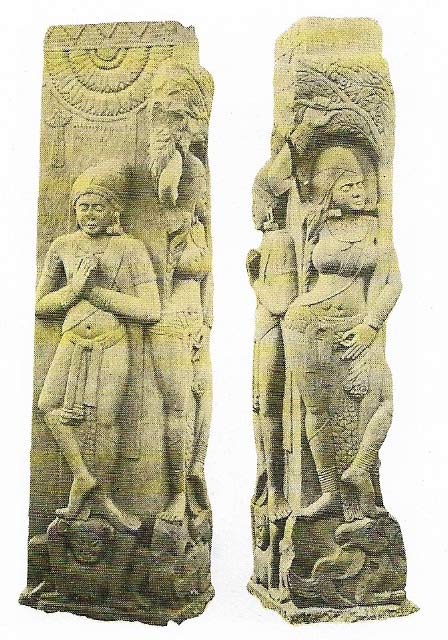
Figure 1. The figures of tree-spirits on this 1st-century BC railing pillar from Bharut have a low relief and more formalized design than some of the later representations of tree-spirits. They made their contribution to later Indian sculpture, in which free-standing figures were not as popular as those that were carried out in high relief and made to be viewed from the front.
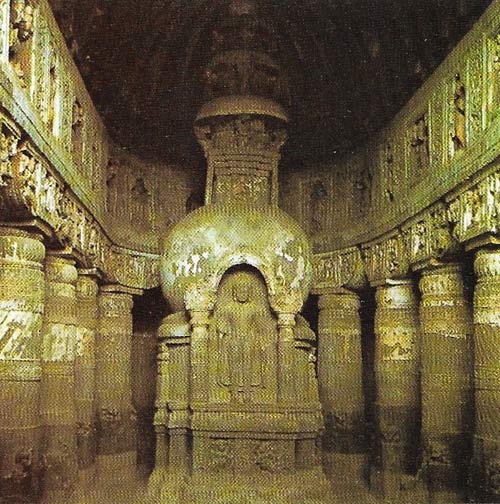
Figure 2. In the famous Ajanta caves every detail was cut from solid rock that forms part of a hillside. They were made between the 2nd century BC and the 9th century AD. The construction of the 7th-century Buddhist worship hall shown here can be compared with a church, having a nave, aisles and apse; the stupa, and seated Buddha (top, center) make up the focal point of the whole design.
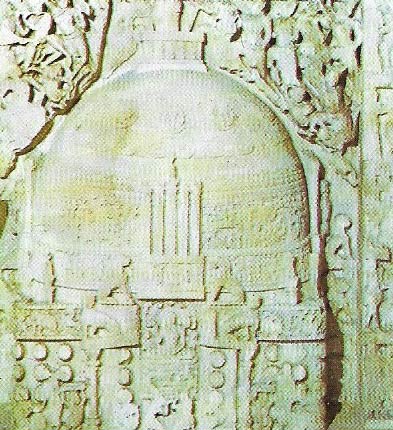
Figure 3. This low relief formerly decorated the lower part of a stupa similar to the one it illustrates. Made in about 2nd century AD, it came from one of the many Buddhist stupas at Amaravati.
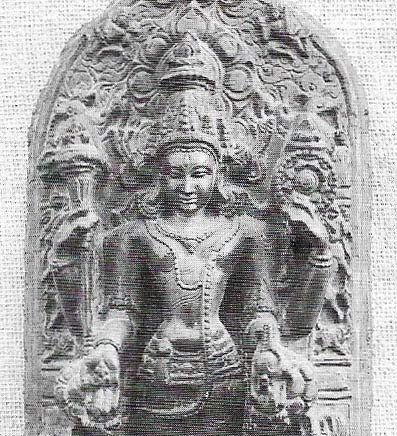
Figure 4. The sculpture of the Pala-Sena period (8th–12th century AD), such as this figure of Vishnu, shows a remarkable development both stylistically and in the deities portrayed. Some of the compositions were simple and restrained whereas others showed either figures in violent movement or in complex groups. Articles of dress, such as crowns, jewelry, robes and symbols, became more detailed. Sculpture was carved in grey sandstone or polished basalt.
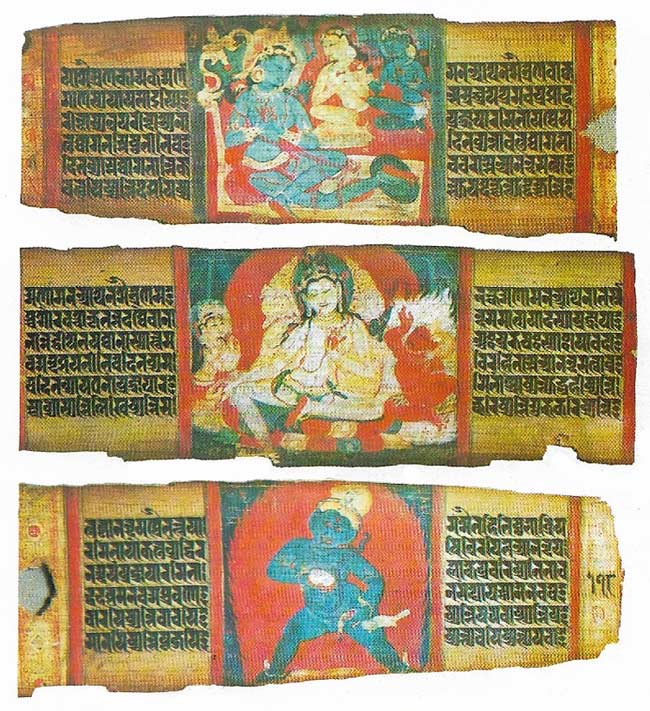
Figure 5. These palm-leaf illuminated manuscripts of the 12th century are some of the earliest examples of Indian painting other than wall-painting. Is is likely that there were earlier examples that have not survived, as these show evidence of mature development. Unlike later Indian miniature, which developed from them, they did not necessarily illustrate the text but contributed to its sanctity as a religious object.
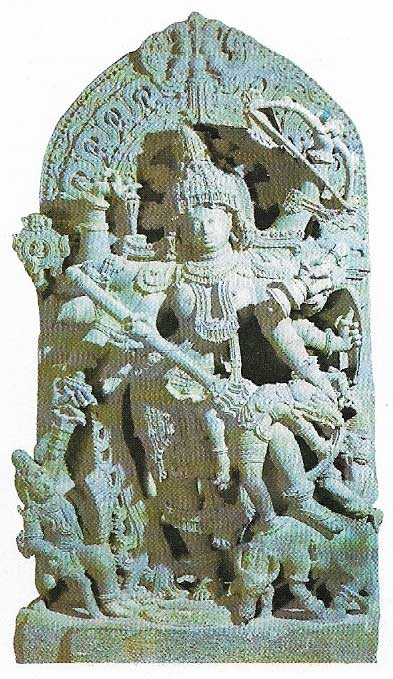
Figure 6. The Hindu art of Mysore in the 13th century is exemplified in this impressive sculpture. It originally formed part of an elaborate scheme decorating the outside of a temple. It is executed with characteristically fussy and meticulous treatment of details such as jewelry, costume and ornamental motifs. It shows a form of the goddess Durga overcoming the buffalo-demon Mahisha. Like many Indian deities she has several arms; they are necessary to hold the attributes ascribed to deities, partly to symbolise their power, partly to distinguish them from other deities. Durga holds the symbols of several gods who combined to defeat the demon.
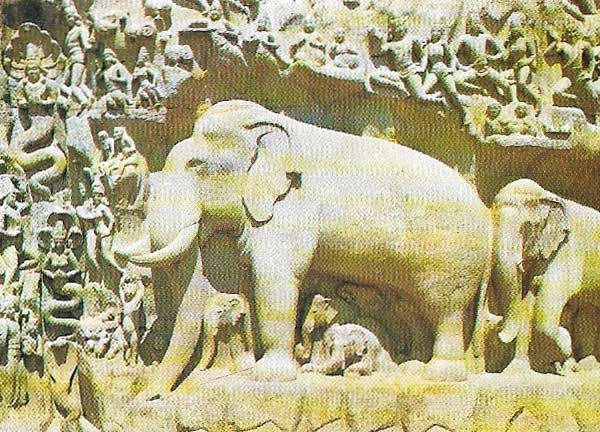
Fig 7. Free-standing temples were also carved in India out of natural rock outcrops, such as the Kailasanatha at Ellora. In Southeastern India in the 7th and 8th centuries, a series of temples and huge reliefs, such as this one showing the descent of the Ganges, were hewn from granite rocks near the sea-shore at Mahabalipuram. They show a masterly control of form and design, especially when carried out in such a difficult medium.
The beginning of Indian art can be traced to the Indus Valley culture of Harappa and Mohenjo-daro (Pakistan) dating from about 2300 BC. At these two sites small examples of rather naturalistic as well as stylized sculpture were found that show a considerable understanding of the treatment of the human figure both in stone and in bronze. Clay figures in a somewhat primitive style were made and possibly represent popular art; in contrast, steatite seals showing animals and figures were cut in a tight, formalized design.
Mastery of sculptural technique
In the historical gap between this period and the Mauryan era (320–185 BC) it is clear that the Indian craftsman achieved complete control of his medium. The Ashokan pillar capitals, such as that from Sarnath adopted as the national emblem of India, show both stylized lions and a more naturalistic treatment of animals carried out in polished sandstone. This technique is a characteristic of Mauryan sculpture and it continued into a slightly later period. The yakshi, although not a Mauryan piece, also has a polished stone surface. This was probably intended for worship but it is remarkable for its unspiritual treatment of the female figure. This combination of the religious and the sensuous is found throughout Indian art. Similarly, it is not unusual for sculptured pairs of embracing figures (maithuna) to be found in a religious context in cave temples or in erotic postures adorning the outside of temples.
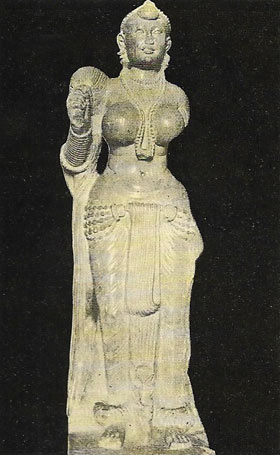 |
| This fly-whisk bearer of polished sandstone comes from Didarganj (Bihar) and is of the 1st century AD. From its resemblance to figures at Sanchi and Bharut it is likely that this is a statue of a tree-spirit deity (yaksha). The fly-whisk is a symbol of power and is the only visual indication that this figure is not an ordinary mortal. It is in sharp contrast to later sculpture, showing figures that leave no doubt as to their status as deities. This image, although early, shows something of the significance with which female deities were eventually to be invested by Indian religion. |
It is likely that major deities were not personalized but represented by symbols until the first two centuries AD an important development took place, as a result of the cult of bhakti (worship of a personal god), at that time images became the main icon. The change seems to have occurred in two places simultaneously, in Gandhara (now northwestern Pakistan and northeastern Afghanistan) and Mathura (southeastern Delhi), with some interaction.
Hellenistic influences on sculpture
In Gandhara, as a result of latent Hellenism remaining after the eastern extension of Greek culture, a style of sculpture arose that was deeply influenced by Hellenistic ideas. These concerned not only interest in the human figure and the treatment of drapery but also the physical idealization of the deity. Whereas in Gandhara the religion served by sculpture was almost entirely Buddhist, at Mathura Hinduism and Buddhism existed side by side. Here also the style of the images was more Indian, and the style used was frequently a mottled red or fawn sandstone instead of the grey schist in which most Gandhara stone sculpture was executed. The later (Gupta) Mathura Buddha figures, in which the robes appear to stick to the torso smoothly or in ridges as if they were wet, later became the exemplar of many other statues of Buddha that were made wherever Indian Buddhist culture spread.
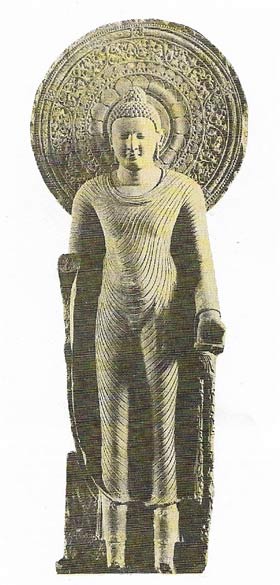 |
| This elegant sandstone Buddha figure from Mathura was made in the Gupta period, about the 5th century AD. It expresses serene contemplation with a feeling for form and decorative style. |
Although brick and stone buildings were made, most of the remaining architecture from the first two centuries AD comprises caves and formalized Buddhist burial mounds (stupas) (Figures 2 and 3). The caves, such as those at Karli, Ellora, and Ajanta, were cut from natural rock strata mainly between the 2nd century BC and the 9th century AD for the worship of all three of the main Indian religions, Hindu, Buddhist and Jain. Some were unadorned, but others were decorated with sculpture and painting.
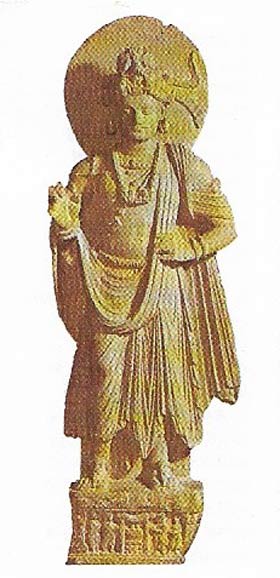 |
| Late Hellenistic influence can be seen in the style of this 2nd-4th century AD image of a Bodhisattva (Buddha-to-be) from Gandhara. Many conventional motifs in later Buddhist art originated in the sculpture of this period. |
Some impressive free-standing rock-cut temples were also made both in the western and southeastern Deccan. The shore temples at Mahabalipuram are the finest (10). At the sites shared by more than one religion (as at Ellora) there is no difference in the artistic style adopted, which tends to be regional rather then sectarian. It is likely that much sculpture was painted in naturalistic colors, as in ancient Greece.
The theory and practice of sculpture and architecture were recorded in texts (silpa sastras) that probably had a wide distribution. In spite of this, Indian art is remarkable for the variety and sensitivity of its treatment of religious subjects. This is particularly noticeable if its bronze sculpture is compared with the stone sculpture of Orissa belonging to the eleventh and twelfth centuries. In contrast, an elaborate and agitated style grew up in Mysore during the Hoyshala dynasty (late 12th to 14th centuries) which is attractive in its unrestrained exuberance.
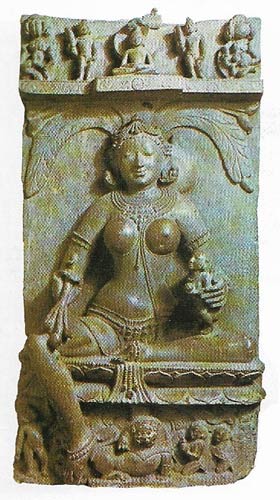 |
| Orissa produced a characteristic local sculptural style, shared by all sects. It is illustrated by this 11th-century Jain figure of the mother-goddess Ambika that continues early traditions. |
A little earlier, in Bengal and Bihar prior to the Muslim invasions, the art of the Pala-Sena period (8th to 12th centuries) flourished under generous royal patronage and religious fervor. Bronze and stone sculptures were produced in great variety and quantity (Figure 4) and had an important influence throughout Eastern Asia. It was at that period that many of the forms of Indian deities, later accepted as conventional, were created in this part of the subcontinent and in the south.
Surviving examples of Indian painting
Painting also achieved high standards of skill as the wall paintings of the cave temples of the western Deccan (such as those at Ajanta) bear evidence. They suggest a long period of development and it is almost certain that there were other forms of painting that have now disappeared. Those on birch bark were especially susceptible to decay although a few examples have survived. Others, including illuminated palm-leaf manuscripts (Figure 5), remain and exhibit a mastery over line and brilliant color that was to influence early Nepalese painting and the woodcuts of Tibet.
